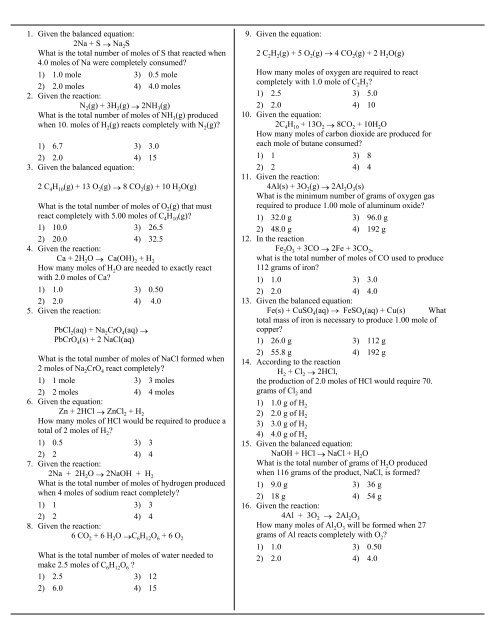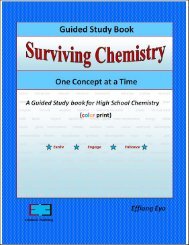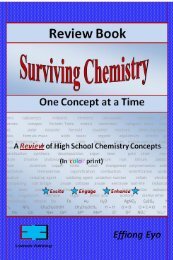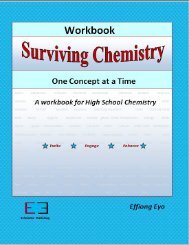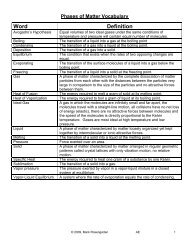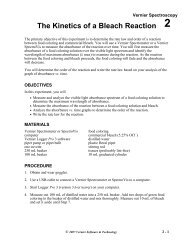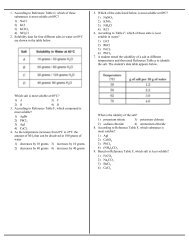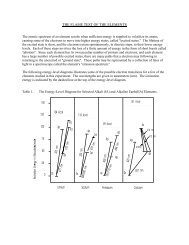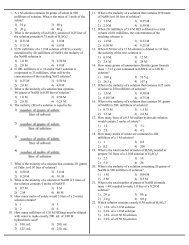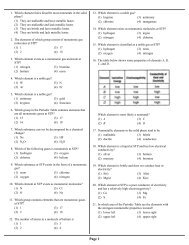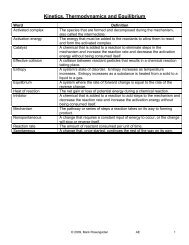1. Given the balanced equation - Revsworld
1. Given the balanced equation - Revsworld
1. Given the balanced equation - Revsworld
You also want an ePaper? Increase the reach of your titles
YUMPU automatically turns print PDFs into web optimized ePapers that Google loves.
<strong>1.</strong> <strong>Given</strong> <strong>the</strong> <strong>balanced</strong> <strong>equation</strong>:<br />
2Na + S → Na 2 S<br />
What is <strong>the</strong> total number of moles of S that reacted when<br />
4.0 moles of Na were completely consumed?<br />
1) <strong>1.</strong>0 mole 3) 0.5 mole<br />
2) 2.0 moles 4) 4.0 moles<br />
2. <strong>Given</strong> <strong>the</strong> reaction:<br />
N 2 (g) + 3H 2 (g) → 2NH 3 (g)<br />
What is <strong>the</strong> total number of moles of NH 3 (g) produced<br />
when 10. moles of H 2 (g) reacts completely with N 2 (g)?<br />
1) 6.7 3) 3.0<br />
2) 2.0 4) 15<br />
3. <strong>Given</strong> <strong>the</strong> <strong>balanced</strong> <strong>equation</strong>:<br />
2 C 4 H 10 (g) + 13 O 2 (g) → 8 CO 2 (g) + 10 H 2 O(g)<br />
What is <strong>the</strong> total number of moles of O 2 (g) that must<br />
react completely with 5.00 moles of C 4 H 10 (g)?<br />
1) 10.0 3) 26.5<br />
2) 20.0 4) 32.5<br />
4. <strong>Given</strong> <strong>the</strong> reaction:<br />
Ca + 2H 2 O → Ca(OH) 2 + H 2<br />
How many moles of H 2 O are needed to exactly react<br />
with 2.0 moles of Ca?<br />
1) <strong>1.</strong>0 3) 0.50<br />
2) 2.0 4) 4.0<br />
5. <strong>Given</strong> <strong>the</strong> reaction:<br />
PbCl 2 (aq) + Na 2 CrO 4 (aq) →<br />
PbCrO 4 (s) + 2 NaCl(aq)<br />
What is <strong>the</strong> total number of moles of NaCl formed when<br />
2 moles of Na 2 CrO 4 react completely?<br />
1) 1 mole 3) 3 moles<br />
2) 2 moles 4) 4 moles<br />
6. <strong>Given</strong> <strong>the</strong> <strong>equation</strong>:<br />
Zn + 2HCl → ZnCl 2 + H 2<br />
How many moles of HCl would be required to produce a<br />
total of 2 moles of H 2 ?<br />
1) 0.5 3) 3<br />
2) 2 4) 4<br />
7. <strong>Given</strong> <strong>the</strong> reaction:<br />
2Na + 2H 2 O → 2NaOH + H 2<br />
What is <strong>the</strong> total number of moles of hydrogen produced<br />
when 4 moles of sodium react completely?<br />
1) 1 3) 3<br />
2) 2 4) 4<br />
8. <strong>Given</strong> <strong>the</strong> reaction:<br />
6 CO 2 + 6 H 2 O →C 6 H 12 O 6 + 6 O 2<br />
What is <strong>the</strong> total number of moles of water needed to<br />
make 2.5 moles of C 6 H 12 O 6 ?<br />
1) 2.5 3) 12<br />
2) 6.0 4) 15<br />
9. <strong>Given</strong> <strong>the</strong> <strong>equation</strong>:<br />
2 C 2 H 2 (g) + 5 O 2 (g) - 4 CO 2 (g) + 2 H 2 O(g)<br />
How many moles of oxygen are required to react<br />
completely with <strong>1.</strong>0 mole of C 2 H 2 ?<br />
1) 2.5 3) 5.0<br />
2) 2.0 4) 10<br />
10. <strong>Given</strong> <strong>the</strong> <strong>equation</strong>:<br />
2C 4 H 10 + 13O 2 → 8CO 2 + 10H 2 O<br />
How many moles of carbon dioxide are produced for<br />
each mole of butane consumed?<br />
1) 1 3) 8<br />
2) 2 4) 4<br />
1<strong>1.</strong> <strong>Given</strong> <strong>the</strong> reaction:<br />
4Al(s) + 3O 2 (g) → 2Al 2 O 3 (s)<br />
What is <strong>the</strong> minimum number of grams of oxygen gas<br />
required to produce <strong>1.</strong>00 mole of aluminum oxide?<br />
1) 32.0 g 3) 96.0 g<br />
2) 48.0 g 4) 192 g<br />
12. In <strong>the</strong> reaction<br />
Fe 2 O 3 + 3CO → 2Fe + 3CO 2 ,<br />
what is <strong>the</strong> total number of moles of CO used to produce<br />
112 grams of iron?<br />
1) <strong>1.</strong>0 3) 3.0<br />
2) 2.0 4) 4.0<br />
13. <strong>Given</strong> <strong>the</strong> <strong>balanced</strong> <strong>equation</strong>:<br />
Fe(s) + CuSO 4 (aq) - FeSO 4 (aq) + Cu(s) What<br />
total mass of iron is necessary to produce <strong>1.</strong>00 mole of<br />
copper?<br />
1) 26.0 g 3) 112 g<br />
2) 55.8 g 4) 192 g<br />
14. According to <strong>the</strong> reaction<br />
H 2 + Cl 2 → 2HCl,<br />
<strong>the</strong> production of 2.0 moles of HCl would require 70.<br />
grams of Cl 2 and<br />
1) <strong>1.</strong>0 g of H 2<br />
2) 2.0 g of H 2<br />
3) 3.0 g of H 2<br />
4) 4.0 g of H 2<br />
15. <strong>Given</strong> <strong>the</strong> <strong>balanced</strong> <strong>equation</strong>:<br />
NaOH + HCl → NaCl + H 2 O<br />
What is <strong>the</strong> total number of grams of H 2 O produced<br />
when 116 grams of <strong>the</strong> product, NaCl, is formed?<br />
1) 9.0 g 3) 36 g<br />
2) 18 g 4) 54 g<br />
16. <strong>Given</strong> <strong>the</strong> reaction:<br />
4Al + 3O 2 → 2Al 2 O 3<br />
How many moles of Al 2 O 3 will be formed when 27<br />
grams of Al reacts completely with O 2 ?<br />
1) <strong>1.</strong>0 3) 0.50<br />
2) 2.0 4) 4.0
17. <strong>Given</strong> <strong>the</strong> reaction:<br />
2C 2 H 6 + 7O 2 → 4CO 2 + 6H 2 O<br />
What is <strong>the</strong> total number of CO 2 molecules produced<br />
when one mole of C 2 H 6 is consumed?<br />
1) 6.02 × 10 23 3) 3(6.02 × 10 23 )<br />
2) 2(6.02 × 10 23 ) 4) 4(6.02 × 10 23 )<br />
18. In a laboratory experiment, a student reacted 2.8 grams<br />
of Fe(s) (steel wool) in excess CuSO 4 (aq), according to<br />
<strong>the</strong> following <strong>balanced</strong> <strong>equation</strong>:<br />
Fe(s) + CuSO 4 (aq) → FeSO 4 (aq) + Cu(s)<br />
When <strong>the</strong> Fe(s) was completely consumed, <strong>the</strong><br />
precipitated Cu(s) had a mass of 3.2 grams. Did <strong>the</strong><br />
student's result in this experiment verify <strong>the</strong> mole ratio of<br />
Fe(s) to Cu(s) as predicted by <strong>the</strong> <strong>equation</strong>?<br />
1) Yes, because <strong>the</strong> experimental result was 2:<strong>1.</strong><br />
2) No, because <strong>the</strong> experimental result was 2:<strong>1.</strong><br />
3) Yes, because <strong>the</strong> experimental result was 1:<strong>1.</strong><br />
4) No, because <strong>the</strong> experimental result was 1:<strong>1.</strong><br />
19. <strong>Given</strong> <strong>the</strong> reaction:<br />
Cu + 4HNO 3 → Cu(NO 3 ) 2 + 2H 2 O + 2NO 2<br />
What is <strong>the</strong> total mass of H 2 O produced when 32 grams<br />
of Cu is completely consumed?<br />
1) 9.0 g 3) 36 g<br />
2) 18 g 4) 72 g<br />
20. <strong>Given</strong> <strong>the</strong> reaction:<br />
N 2 + 3H 2 → 2NH 3<br />
How many grams of ammonia are produced when <strong>1.</strong>0<br />
mole of nitrogen reacts?<br />
1) 8.5 3) 34<br />
2) 17 4) 68<br />
2<strong>1.</strong> Magnesium was reacted with an excess of dilute<br />
hydrochloric acid and <strong>the</strong> hydrogen gas produced<br />
collected in a eudiometer. The volume of hydrogen in <strong>the</strong><br />
eudiometer was corrected to conditions of STP. If 94.1<br />
milliliters of hydrogen was produced, how much<br />
magnesium reacted in this experiment?<br />
1) 0.01 g 3) 0.05 g<br />
2) 0.10 g 4) 0.50 g<br />
22. <strong>Given</strong> <strong>the</strong> <strong>equation</strong>:<br />
6CO 2 (g) + 6H 2 O(l) → C 6 H 12 O 6 (s) + 6O 2 (g)<br />
What is <strong>the</strong> minimum number of liters of CO 2 (g),<br />
measured at STP, needed to produce 32.0 grams of<br />
oxygen?<br />
1) 264 L 3) 192 L<br />
2) 32.0 L 4) 22.4 L<br />
23. <strong>Given</strong> <strong>the</strong> reaction:<br />
Mg + H 2 SO 4 → MgSO 4 + H 2<br />
How many grams of H 2 SO 4 are needed to produce<br />
exactly 1<strong>1.</strong>2 liters of H 2 , measured at STP?<br />
1) 24.5 3) 98.0<br />
2) 49.0 4) 196<br />
24. <strong>Given</strong> <strong>the</strong> reaction<br />
N 2 (g) + 3H 2 (g) → 2NH 3 (g)<br />
How many liters of ammonia, measured at STP, are<br />
produced when 28.0 grams of nitrogen is completely<br />
consumed?<br />
1) 5.60 3) 22.4<br />
2) 1<strong>1.</strong>2 4) 44.8
25. In a laboratory experiment, a student determined <strong>the</strong> mass of <strong>the</strong> product, KClO 3 (s), to be 45.7 grams.<br />
a. Calculate <strong>the</strong> gram formula mass of KClO 3 (s). Round atomic masses from <strong>the</strong> Periodic Table to <strong>the</strong> nearest tenth. [Show all<br />
work. Indicate <strong>the</strong> correct answer in proper significant figures and include an appropriate unit.]<br />
b. Calculate <strong>the</strong> number of moles of KClO 3 (s) produced. [Show all work. Indicate <strong>the</strong> correct answer in proper significant figures.]<br />
26. <strong>Given</strong> <strong>the</strong> un<strong>balanced</strong> <strong>equation</strong>:<br />
__Al 2 (SO 4 ) 3 + __Ca(OH) 2 → __Al(OH) 3 + __CaSO 4<br />
Balance <strong>the</strong> <strong>equation</strong> using smallest whole number<br />
coefficients.<br />
27. Base your answer to <strong>the</strong> following question on <strong>the</strong> un<strong>balanced</strong> <strong>equation</strong> provided:<br />
___ C 5 H 12 (g) + ___ O 2 (g) → ___ CO 2 (g) + ___ H 2 O(g)<br />
Balance <strong>the</strong> <strong>equation</strong> using <strong>the</strong> smallest whole-number coefficients.<br />
28. <strong>Given</strong> <strong>the</strong> compound C 4 H 10 O 8,<br />
a Calculate <strong>the</strong> molar masss of <strong>the</strong> compound.<br />
b<br />
c<br />
Calculate <strong>the</strong> number of moles in 17.7 grams of <strong>the</strong> compound.<br />
What is <strong>the</strong> empirical formula for this compound?<br />
29. Base your answer to <strong>the</strong> following question on <strong>the</strong> information and <strong>equation</strong> below.<br />
Antacids can be used to neutralize excess stomach acid. Brand Aantacid contains <strong>the</strong> acid-neutralizing agent magnesium<br />
hydroxide, Mg(OH) 2 . It reacts with HCl(aq) in <strong>the</strong> stomach, according to <strong>the</strong> following <strong>balanced</strong> <strong>equation</strong>:<br />
2 HCl(aq) + Mg(OH) 2 (s) → MgCl 2 (aq) + 2 H 2 O(…)<br />
If a person produces 0.050 mole of excess HCl in <strong>the</strong> stomach, how many moles of Mg(OH) 2 are needed to neutralize this excess<br />
hydrochloric acid?<br />
30. Base your answer to <strong>the</strong> following question on <strong>the</strong> <strong>balanced</strong> chemical <strong>equation</strong> below.<br />
2 H 2 O → 2 H 2 + O 2<br />
How does <strong>the</strong> <strong>balanced</strong> chemical <strong>equation</strong> show <strong>the</strong> Law of Conservation of Mass?<br />
3<strong>1.</strong> A student heats a 243 gram sample of BaCl 2 • 2H 2 O hydrated crystals?<br />
a What was <strong>the</strong> percentage by mass of water in <strong>the</strong> hydrated crystals?[Show all work]<br />
b If all <strong>the</strong> water was driven out of <strong>the</strong> crystal, what would be <strong>the</strong> expected weight of <strong>the</strong> BaCl 2 sample remaining?[Show all work]
32. Base your answer to <strong>the</strong> following question on <strong>the</strong><br />
information below, which describes <strong>the</strong> smelting of iron<br />
ore, and on your knowledge of chemistry.<br />
In <strong>the</strong> smelting of iron ore, Fe 2 O 3 is reduced in a blast<br />
furnace at high temperature by a reaction with carbon<br />
monoxide. Crushed limestone, CaCO 3 , is also added to<br />
<strong>the</strong> mixture to remove impurities in <strong>the</strong> ore. The carbon<br />
monoxide is formed by <strong>the</strong> oxidation of carbon(coke), as<br />
shown in <strong>the</strong> reaction below:<br />
2 C + O2 - 2 CO + energy<br />
Liquid iron flows from <strong>the</strong> bottom of <strong>the</strong> blast furnace<br />
and is processed into different alloys of iron.<br />
Balance <strong>the</strong> <strong>equation</strong> for <strong>the</strong> reaction of Fe 2 O 3 and CO<br />
using <strong>the</strong> smallest whole-number coefficients.<br />
Base your answers to questions 33 and 34 on <strong>the</strong> particle diagrams below, which show atoms and/or molecules in three different samples of<br />
matter at STP.<br />
33. Which sample represents a pure substance?<br />
34. Explain why (x)(x) does not represent a compound.
35. The following procedures are carried out during a laboratory activity to determine <strong>the</strong> mass in grams of CuSO 4 in a hydrated sample<br />
of CuSO 4 •5H 2 O.<br />
Step 1 Determine <strong>the</strong> mass in grams of <strong>the</strong> crucible and CuSO 4 •5H 2 O.<br />
Step 2 Determine <strong>the</strong> mass in grams of <strong>the</strong> crucible and CuSO 4<br />
Step 3 Determine <strong>the</strong> mass in grams of CuSO 4 •5H 2 O.<br />
Step 4 Determine <strong>the</strong> mass in grams of <strong>the</strong> empty crucible.<br />
Step 5 Determine <strong>the</strong> mass in grams of CuSO 4<br />
Arrange <strong>the</strong> steps above in <strong>the</strong> order that <strong>the</strong> student should use to determine <strong>the</strong> mass of CuSO 4 in <strong>the</strong> sample.<br />
_______, _______, _______, _______, ________<br />
36. Base your answers to <strong>the</strong> following questions on <strong>the</strong> information below.<br />
For health reasons, <strong>the</strong> element chlorine is added to <strong>the</strong> drinking water because it will kill disease-causing<br />
organisms. Typically 0.50 ppm of chlorine is added to drinking water to make it safe.<br />
In 2.0 liters of drinking water (2000.g), how many grams of chlorine is present?[Show all work. Include in your answer proper<br />
units and significant figures.]<br />
37. In a laboratory experiment, a student determined <strong>the</strong> mass of <strong>the</strong> product, CaSO 4 (s), to be 3<strong>1.</strong>9 grams.<br />
a Calculate <strong>the</strong> gram formula mass of CaSO 4 (s). Round atomic masses from <strong>the</strong> Periodic Table to <strong>the</strong> nearest tenth. [Show all<br />
work. Indicate <strong>the</strong> correct answer in proper significant figures and include an appropriate unit.]<br />
b Calculate <strong>the</strong> number of moles of CaSO 4 (s) produced. [Show all work.<br />
Indicate <strong>the</strong> correct answer in proper significant figures.]<br />
38. In a laboratory experiment, a student determined <strong>the</strong> mass of <strong>the</strong> product, NaCl(s), to be <strong>1.</strong>84 grams.<br />
a Calculate <strong>the</strong> gram formula mass of NaCl(s). Round atomic masses from <strong>the</strong> Periodic Table to <strong>the</strong> nearest tenth. [Show all work.<br />
Indicate <strong>the</strong> correct answer, including an appropriate unit.]<br />
b Calculate <strong>the</strong> number of moles of NaCl(s) produced. Show all work. Indicate <strong>the</strong> correct answer.<br />
39. <strong>Given</strong> <strong>the</strong> un<strong>balanced</strong> <strong>equation</strong>:<br />
__NH 3 + __O 2 → __HNO 3 + __ H 2 O<br />
balance <strong>the</strong> <strong>equation</strong> using <strong>the</strong> smallest whole number<br />
coefficients.
40. In a laboratory experiment, a student determined <strong>the</strong> mass of <strong>the</strong> product, HgBr(s), to be 98.7 grams.<br />
a Calculate <strong>the</strong> gram formula mass of HgBr(s). Round atomic masses from <strong>the</strong> Periodic Table to <strong>the</strong> nearest tenth. [Show all work.<br />
Indicate <strong>the</strong> correct answer in proper significant figures and include an appropriate unit.]<br />
b Calculate <strong>the</strong> number of moles of HgBr(s) produced. [ Show all work. Indicate <strong>the</strong> correct answer in proper significant figures.]<br />
4<strong>1.</strong> <strong>Given</strong> <strong>the</strong> un<strong>balanced</strong> <strong>equation</strong>:<br />
__Li + __N 2 → __Li 3 N<br />
balance <strong>the</strong> <strong>equation</strong> using smallest whole number<br />
coefficients.<br />
42. Base your answers to <strong>the</strong> following questions on <strong>the</strong> information below.<br />
Rockets use as fuel, liquid hydrogen, H 2 (l) and liquid oxygen , O 2 (l) , which react toge<strong>the</strong>r forming hot gaseous<br />
water. This reaction provides <strong>the</strong> energy to lift <strong>the</strong> <strong>the</strong> shuttle and it's crew.<br />
Write a <strong>balanced</strong> <strong>equation</strong> for <strong>the</strong> reaction of liquid hydrogen with liquid oxygen to produce gaseous water. Include <strong>the</strong> energy term<br />
( " + energy" ) in your <strong>equation</strong>.<br />
43. In a laboratory experiment, a student determined <strong>the</strong> mass of <strong>the</strong> product, LiCl(s), to be 0.333 grams.<br />
a Calculate <strong>the</strong> gram formula mass of LiCl(s). Round atomic masses from <strong>the</strong> Periodic Table to <strong>the</strong> nearest tenth. [Show all work.<br />
Indicate <strong>the</strong> correct answer in proper significant figures and include an appropriate unit.]<br />
b Calculate <strong>the</strong> number of moles of LiCl(s) produced. [Show all work. Indicate <strong>the</strong> correct answer in proper significant figures.]<br />
44. In a laboratory experiment, a student determined <strong>the</strong> mass of <strong>the</strong> product, NaNO 3 (s), to be 0.105 grams.<br />
a. Calculate <strong>the</strong> gram formula mass of NaNO 3 (s). Round atomic masses from <strong>the</strong> Periodic Table to <strong>the</strong> nearest tenth. [ Show all<br />
work. Indicate <strong>the</strong> correct answer in proper significant figures and include an appropriate unit.]<br />
b. Calculate <strong>the</strong> number of moles of NaNO 3 (s) produced. [Show all work. Indicate <strong>the</strong> correct answer in proper significant figures.]
Reference Tables
Answer Key<br />
<strong>1.</strong> 2<br />
29. 0.025<br />
2. 1<br />
3. 4<br />
30. Acceptable responses: 4 H and 2 O on both sides; 4 H = 4 H<br />
and 2 O = 2 O; same number of each element on both sides.<br />
4. 4<br />
3<strong>1.</strong> a) 36/ (137 + 71 + 36) × 100 = 15% b) 207 grams<br />
5. 4<br />
32. 1 Fe 2 O 3 + 3 CO - 2 Fe + 3 CO 2<br />
6. 4<br />
33. Allow credit for 3.<br />
7. 2<br />
34. Acceptable responses: A compound must contain two or more<br />
8. 4<br />
different elements, only 1 kind of atom present.<br />
9. 1<br />
35. 4,1,3,2,5<br />
36. 0.0010 g<br />
10. 4<br />
37. a) 40.1 + 32.1 + 4(16.0) = 136.2 g b) 3<strong>1.</strong>9g x <strong>1.</strong>00<br />
1<strong>1.</strong> 2<br />
mole/136.2g = 0.234 mole<br />
12. 3<br />
38. a) 23.0 + 35.5 = 58.5 g b) <strong>1.</strong>84 g × <strong>1.</strong>00 mole/58.5 g =<br />
0.0315 mole<br />
13. 2<br />
39. 1 NH 3 + 2 O 2 → 1 HNO 3 + 1 H 2 O<br />
14. 2<br />
40. a) 200.6 + 79.9 = 280.5g b) 98.7g × <strong>1.</strong>00 mole/280.5g =<br />
15. 3<br />
0.352 mole<br />
16. 3<br />
4<strong>1.</strong> _6_Li + _1_N 2 → _2_Li 3 N<br />
17. 2<br />
42. 2 H 2 (l) + O 2 (l) → 2 H 2 O(g) + energy<br />
18. 3<br />
43. a) 6.9 + 35.5 = 42.4g b) 0.333g × <strong>1.</strong>00 mole/42.4g =<br />
0.00785 mole<br />
19. 2<br />
44. a) 23.0 + 14.0 + 3(16.0) = 85.0 g b) 0.105g x <strong>1.</strong>00<br />
20. 3<br />
mole/85.0g = 0.00124 mole<br />
2<strong>1.</strong> 2<br />
22. 4<br />
23. 2<br />
24. 4<br />
25. a) 39.1 + 35.5 + 3(16.0) = 122.6 g b) 45.7g x <strong>1.</strong>00<br />
mole/122.6g = .373 mole<br />
26. _1_Al 2 (SO 4 ) 3 + _3_Ca(OH) 2 → _2_Al(OH) 3 + _3_CaSO 4<br />
27. Allow credit for C 5 H 12 (g) + 8 O 2 (g) → 5 CO 2 (g) + 6 H 2 O(g).<br />
Allow credit even if <strong>the</strong> coefficient “1” is written in front of C 5 H 12<br />
(g)


